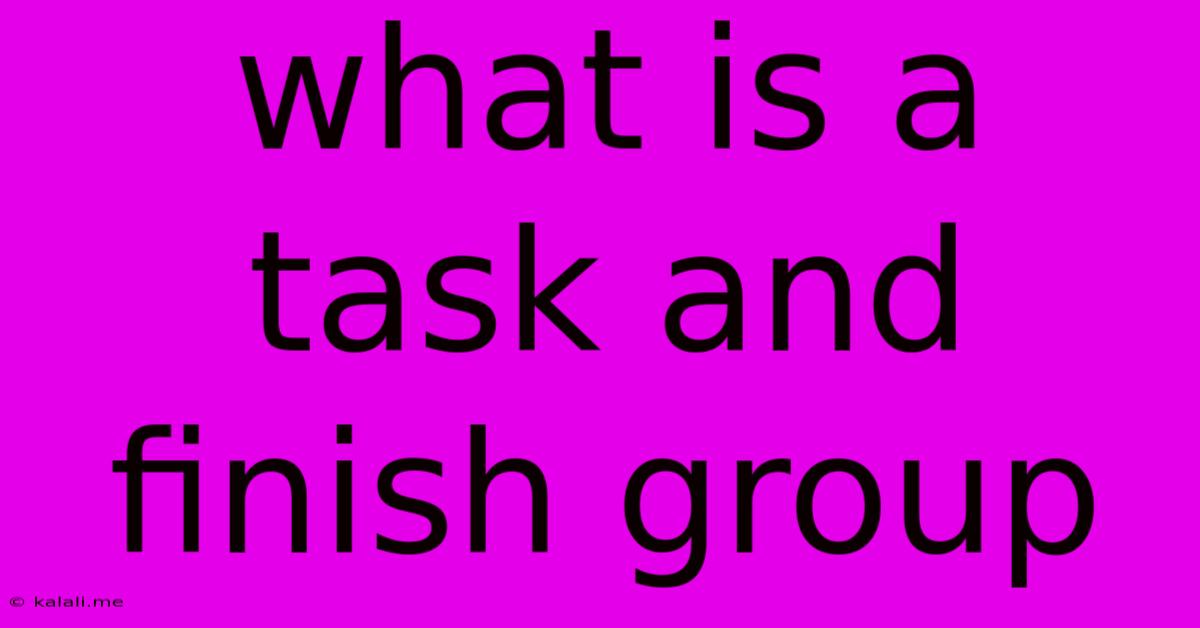What Is A Task And Finish Group
Kalali
May 20, 2025 · 3 min read

Table of Contents
What is a Task and Finish Group? Understanding Temporary Teams for Project Success
Meta Description: Learn about task and finish groups – temporary teams formed to complete specific projects. Discover their advantages, disadvantages, and how to effectively manage them for optimal results. This guide covers everything you need to know about these crucial project elements.
Task and finish groups, also known as project teams or ad-hoc teams, are temporary groups assembled to achieve a specific objective. Unlike permanent teams with ongoing responsibilities, these groups disband once their task is completed. Understanding their structure, benefits, and challenges is crucial for successful project management. This article will delve into the intricacies of task and finish groups, providing insights for both project managers and team members.
Understanding the Structure and Purpose of Task and Finish Groups
These groups are characterized by their temporary nature. They are created with a defined purpose, a clear timeline, and pre-determined deliverables. Members are selected based on their expertise and skills relevant to the project. Once the project is finished and the deliverables are met, the group disbands, and members return to their regular roles.
This structure offers several key advantages:
- Focused Objectives: The temporary nature fosters a sharp focus on the task at hand, minimizing distractions from other responsibilities.
- Flexibility and Adaptability: These teams can be quickly assembled and dissolved, allowing for rapid responses to changing project needs or market demands.
- Cost-Effectiveness: By only utilizing team members for the duration of the project, organizations can minimize payroll costs associated with maintaining permanent teams.
- Innovation and Fresh Perspectives: Bringing together individuals from various departments or backgrounds can spark creativity and lead to innovative solutions.
- Enhanced Employee Engagement: Working on a time-bound project can be motivating for employees, leading to higher engagement and job satisfaction.
Challenges in Managing Task and Finish Groups
While offering significant advantages, managing these temporary teams presents unique challenges:
- Communication: Maintaining effective communication within the group and with other departments can be challenging, especially with a short lifespan.
- Team Cohesion: Building trust and rapport within a short timeframe can be difficult, impacting team performance.
- Knowledge Transfer: Ensuring that the knowledge gained during the project is appropriately documented and transferred to relevant parties after the group disbands is crucial to avoid knowledge loss.
- Resource Allocation: Securing and allocating the necessary resources – including personnel, budget, and tools – can be complex, especially in a fast-paced environment.
- Conflict Resolution: Disagreements among team members can arise quickly, requiring effective conflict resolution strategies.
Best Practices for Managing Task and Finish Groups
To mitigate these challenges and maximize project success, consider these best practices:
- Clearly Define Goals and Roles: Establish clear, measurable, achievable, relevant, and time-bound (SMART) goals from the outset. Assign roles and responsibilities clearly to each team member.
- Establish Effective Communication Channels: Implement regular meetings, utilize project management software, and encourage open communication to keep everyone informed and aligned.
- Foster Team Cohesion: Facilitate team-building activities and encourage social interaction among members to build rapport and trust.
- Develop a Detailed Project Plan: Create a comprehensive project plan that outlines tasks, timelines, milestones, and deliverables.
- Document Lessons Learned: After project completion, conduct a post-mortem to document lessons learned, successes, and areas for improvement. This knowledge can improve future projects.
- Recognize and Reward Contributions: Acknowledge and appreciate individual and team contributions to boost morale and improve future collaboration.
Conclusion: Maximizing the Potential of Task and Finish Groups
Task and finish groups are invaluable for tackling specific projects efficiently. By understanding their structure, addressing potential challenges proactively, and implementing best practices, organizations can leverage the benefits of these temporary teams to achieve optimal results, fostering innovation, and maximizing resource allocation. Effective management is key to transforming these temporary collaborations into powerful engines of project success.
Latest Posts
Latest Posts
-
How To Integrate X 2 1 X 2
May 20, 2025
-
You Scratch My Back I Ll Scratch Yours
May 20, 2025
-
Far Cry 4 Amita Or Sabal
May 20, 2025
-
What Language Did Adam And Eve Speak
May 20, 2025
-
How To Get Rid Of Diesel Smell In Clothes
May 20, 2025
Related Post
Thank you for visiting our website which covers about What Is A Task And Finish Group . We hope the information provided has been useful to you. Feel free to contact us if you have any questions or need further assistance. See you next time and don't miss to bookmark.